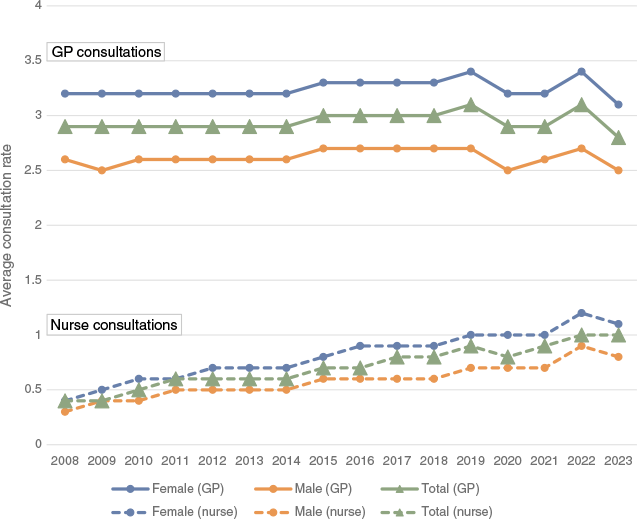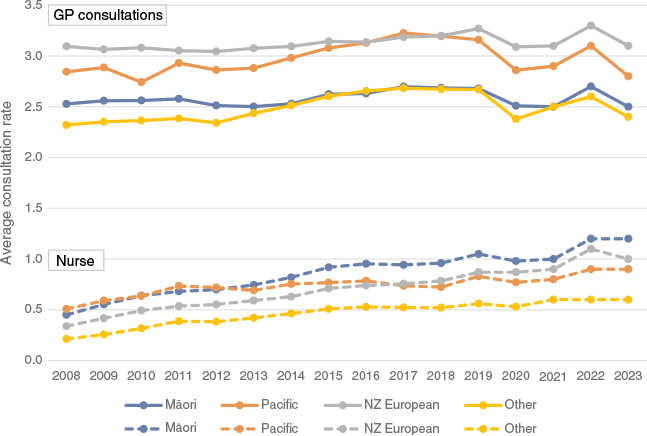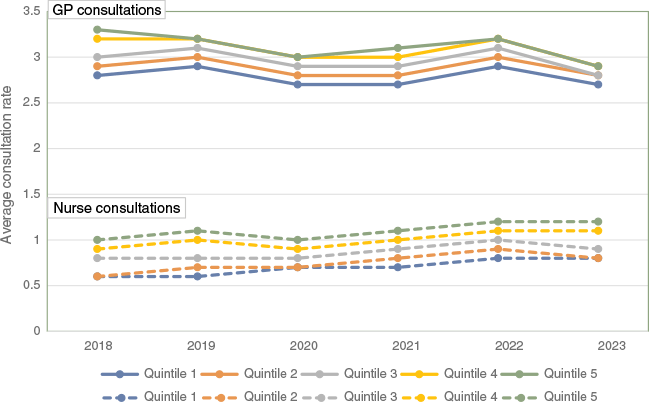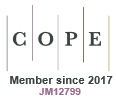Primary health care utilisation in Aotearoa New Zealand: a descriptive study of trends from 2008 to 2023
Mona Jeffreys 1 * , Maite Irurzun Lopez
1 * , Maite Irurzun Lopez  1 , Claire O’Loughlin
1 , Claire O’Loughlin  1 , Tessa Senior 1 , Jacqueline Cumming
1 , Tessa Senior 1 , Jacqueline Cumming  1
1
1
Abstract
The New Zealand Primary Health Care Strategy (2001) and subsequent government health policy have aimed to improve access to and expand the role of nurses in primary health care. Measuring primary healthcare utilisation is one way to assess the success of such policies.
This study aimed to describe trends from 2008 to 2023 in average annual general practitioner (GP) and nurse consultations, by gender, age, ethnicity, and area-level deprivation.
Primary health care service utilisation data were obtained from the Ministry of Health.
Average GP consultations per enrolled patient per year showed little change over the study period, with increases from 2.9 in 2008 to 3.1 in 2022, and a dip in 2020 and 2021 during the COVID-19 pandemic. In 2023, GP consultations were the lowest in the study period (2.8). Nurse consultations rose steadily from 0.4 in 2008 to 1.0 in 2023 and did not show a marked COVID-19-related dip. Māori had consistently lower rates of GP consultations and higher rates of nurse consultations than New Zealand Europeans. Utilisation of primary health care, particularly that provided by GPs, was low in 2023.
Possible reasons for Māori and older people consulting with nurses at higher rates should be investigated. These may be artefactual, due to our inability to age-standardise the data. Other possible reasons include nurse management of chronic conditions and barriers to accessing GP care. The fall in primary healthcare utilisation in 2023 will likely increase secondary care need.
Keywords: access, consultations, equity, general practitioner, nurse, nurse practitioner, primary health care, service utilisation.
| WHAT GAP THIS FILLS |
| What is already known: The Primary Health Care Strategy and subsequent government health policy have aimed to improve access to and expand the role of nurses in primary health care. Utilising nurse expertise had been identified as a potential solution to ease GP workloads. It remains unclear the degree to which this has occurred. |
| What this study adds: This research contributes an up-to-date analysis of trends in primary healthcare consultation rates by practitioner type at a national level, across a 16-year study period that includes those years when the COVID-19 pandemic was at its height. |
Introduction
Primary Health Care (PHC) is the cornerstone of community-based care, with the potential to improve health and health equity, and reduce the burden on secondary health care by reducing avoidable or amenable hospitalisations.1–3 In Aotearoa New Zealand (NZ), access to PHC continues to be a challenge, with barriers to care including cost, transport, owing money to the provider, getting an appointment, and more recently the difficulties in enrolling in PHC services due to many having ‘closed books’.4–6
In NZ, GPs conduct the majority of consultations within PHC teams,7 but the GP workforce is facing increasing shortages8 that have been exacerbated by the COVID-19 pandemic and associated border closures, leading to a reduction in recruitment of overseas-trained GPs.9 As a result, there has been a need for practices to close their books, or no longer enrol new patients, increasing barriers to care.6,10 Although nurses are also facing workforce shortages,11 one solution to ease the GP workload overseas has been to train nurses to fill some of the roles traditionally undertaken by GPs.12,13
The Primary Health Care Strategy (PHCS, 2001) changed and adapted policy and funding for PHC in NZ, with the intention of improving access to and provision of PHC to improve population health.14 One of the main goals of the PHCS was to improve access to PHC by reducing user co-payments. This reduction in co-payments was initially associated with an increase in both GP and nurse PHC consultations (2001–2005), with some practices seeing more than a 20% increase in overall consultations.15 Subsequent government policy has continued to seek an enhanced role for nurses.16–19
Measuring access to PHC is not straightforward. Utilisation, or patterns of consultation rates, as a proxy for access to care, is the approach we have taken in this manuscript, although this does not address issues for those people who are not accessing care. Importantly, a further reason for analysing consultation rates is for workforce planning, and to inform the capitation-based funding formula,20 which remains under review.21,22
Several studies in NZ have investigated utilisation of PHC at different points in time: 1997–1998,23 2001,24 and 2013–2016.25 A study of 66 general practices found that both Māori and Pacific peoples have lower rates of GP consultations and comparatively higher rates of nurse consultations than NZ Europeans.25 Furthermore, there was a clear pattern of higher consultation rates for GPs and nurses with increasing levels of deprivation.25
In this article, we describe national trends in average annual GP and nurse consultations from 2008 to 2023, overall, and by gender, age, ethnicity, and area-level deprivation.
Methods
Service utilisation data
We obtained data from the Ministry of Health (MoH) via an Official Information Act (OIA) request for PHC service utilisation data for the years 2008–2018, and then annual exchanges were conducted to obtain updated utilisation rates for 2019–2023. Since this is publicly available, aggregated data, ethical approval was not required.
Primary Health Organisations (PHOs) collate first-level service utilisation data for practices in their district, as agreed under the PHO Service Agreement.26 The data are checked and summarised by their contracted management organisation, then forwarded to the MoH. This was previously done on a quarterly basis, but since the implementation of the National Enrolment System (NES) in April 2019, this has been done monthly. Data compiled are for all recorded GP and nurse consultations that occur in a general practice, including telehealth, although telephone consultations prior to March 2020 were not regularly included. The data set includes enrolled patients only and does not include consultations that take place outside of the practice. Nurse consultations include those with practice nurses and nurse practitioners (NPs). Results are presented as the average number of consultations per enrolled patient per year. Limitations of the data set are included in the discussion.
Analysis
The data were supplied to us with prioritised ethnicity;27 the category of ‘Other’ ethnic group includes anyone who does not identify as Māori, Pacific, or NZ European. Deprivation was measured using the area-level New Zealand Deprivation Index,28 based on the individual’s home address at the time of enrolment, and analysed in quintiles. Deprivation was used as a reporting category from 2018 onwards.
Results
Overall changes in consultation patterns
The average number of GP consultations showed little change over the 16-year study period. There were small increases from 2.9 in 2008 to 3.1 in 2022, with a dip in 2020 and 2021 during the height of the COVID-19 pandemic. Data for 2023 show the lowest GP consultation rates across the entire study period (2.8). Nurse consultations rose steadily from an average of 0.4 in 2008 to 1.0 in 2023 and did not show such a marked COVID-19-related dip (Fig. 1, Supplementary Tables S1, S2).
Gender
Females had consistently higher rates of both GP and nurse consultations than males across the study period. For GP consultations, this gender difference remained relatively stable, rising slightly from 3.2 (2.6) in 2008 for females (males) to 3.4 (2.7) in 2022. The average number of GP consultations for both females and males dipped in 2020, then rose, and fell again in 2023 (3.1 for females; 2.5 for males). From 2008 to 2022, the average number of nurse consultations for both males and females rose steadily, remaining stable over the pandemic years, and dipping only in 2023 (1.1 for females and 0.8 for males) (Fig. 1). The larger increase over time in average nurse consultations for females (0.4 in 2008 to 1.1 in 2023) compared to males (0.3 in 2008 to 0.8 in 2023) resulted in a widening of the observed gender differences.
Age
People aged over 65 years consistently had the highest consultation rates with both GPs and nurses across the study period (GP: 5.6; nurse: 1.4), while people aged 5–14 years had the lowest (GP: 1.6; nurse: 0.3) (Figs 2, 3, Supplementary Table S3). GP visits decreased for under 5 year and 65+ year age bands from 2008 to 2023; other age groups showed small increases or little change. Children (both under 5 and those aged 5–14 years) had fewer visits during 2020; other age groups were less affected. All age groups showed a dip in number of GP consultations in 2023. Nurse consultations increased for all age bands between 2008 and 2023, with people aged over 65 years experiencing the largest increase (from 0.8 in 2008 to 1.8 in 2023). Children and people aged over 65 years had fewer visits during 2020, and in 2023 nurse consultations decreased for all people aged between 5 and 64 years compared to the previous year.
Average annual GP consultations per enrolled person, by age, 2008–2023. Note the different y-axis scale when compared with Fig. 3.
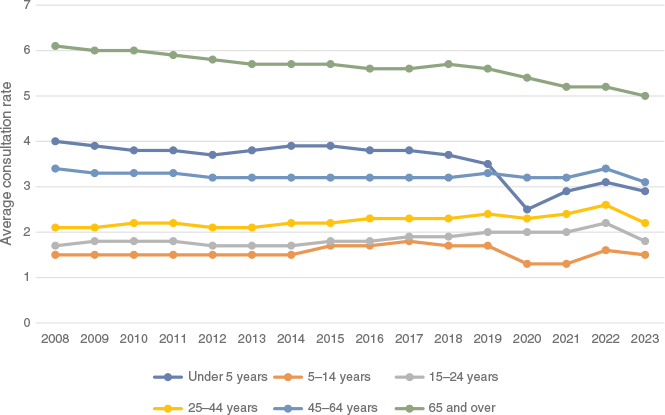
Average annual nurse consultations per enrolled person, by age, 2008–2023. Note the different y-axis scale when compared with Fig. 2.
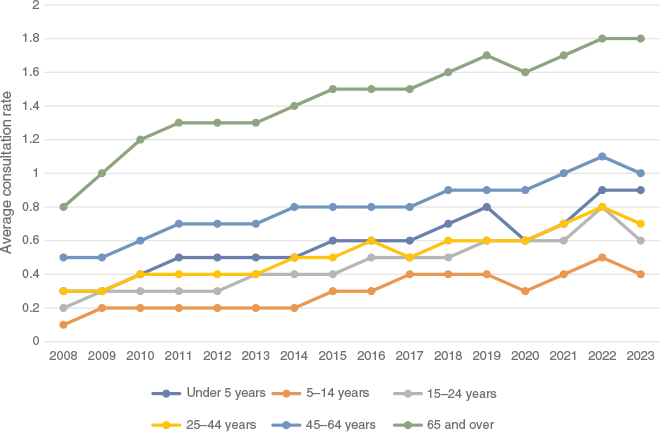
Ethnicity
Māori had consistently lower rates of GP consultations across the study period (mean 2.6 consultations) than Pacific peoples (3.0) and NZ Europeans (3.1). Conversely, Māori had mainly higher rates of nurse consultations across this same period (mean 0.9 consultations) than both Pacific peoples (0.7) and NZ Europeans (0.7). GP consultations decreased for all ethnicities in 2020 and again in 2023. Nurse consultations showed a gradual increase for all ethnicities between 2008 and 2023, with little change over the pandemic years (Fig. 4, Supplementary Table S4).
Household deprivation
From 2018 to 2023, the average number of consultations with both GPs and nurses was higher for those living in the most deprived quintile (mean 3.1 GP; 1.1 nurse) compared with those residing in the least deprived quintile (mean 2.8 GP; 0.7 nurse). GP consultations decreased for all quintiles in 2020 and again in 2023. Over the whole time period, the changes were greatest for people living in deprivation quintiles 4 and 5 (ie the most deprived areas). Nurse consultations showed a modest increase over the time period for all quintiles (Fig. 5, Supplementary Table S5), with only small dips in 2020 for the most deprived two quintiles and for quintiles 2 and 3 in 2023.
Discussion
Examining national trends in GP and nurse consultations from 2008 to 2023 reveals different patterns by practitioner type and demographic group. Although average GP consultations were consistently higher than those for nurses, the average number of nurse consultations for enrolled patients rose steadily over the study period, while GP consultations showed little change. Consultation rates with both GPs and nurses were higher for females, older patients (aged over 65 years), and for those patients residing in areas of highest deprivation. From 2008 to 2023, Māori had consistently lower rates of GP consultations and higher rates of nurse consultations than NZ Europeans. For people aged over 65 years, GP visits decreased, and nurse visits increased over the 16-year study period, while children aged 0–14 years had fewer visits during 2020. Utilisation of PHC, particularly that provided by GPs, was low in 2023.
Analysis of consultation rates can be used to monitor equity of service provision across different population groups. Our data show that Māori had consistently lower rates of GP consultations and higher rates of nurse consultations than NZ Europeans over the 16-year study period. This could be an artefact due to the data not being age-standardised (see ‘Limitations’ section below). Nurse-led care of chronic illnesses could also explain this in part; this has been shown to be associated with better quality and continuity of care.29 Evidence from NZ also shows higher levels of nurse input in practices with higher levels of patient need,30 and a high proportion of NPs working in very low-cost access practices.31
Alternatively, the observed patterns of low GP consultation rates for Māori could be partially explained by the fact that the data exclude casual consultations. Since Māori have lower enrolment rates,32 this could have artificially undercounted the Māori consultation rates that we report. However, considering the well-documented systemic racism that Māori experience in the health system,33,34 other explanations as to why Māori have higher rates of nurse consultations and lower rates of GP consultations than NZ Europeans must be explored.
When compared to other age groups, people aged over 65 years experienced the largest increase in nurse consultations per person while simultaneously experiencing a decrease in GP consultations. Older people often require more complex care than younger people due to a higher prevalence of long-term conditions and disability.35 Management of chronic conditions can appropriately be a nurse-led task because it requires increased regularity of symptom monitoring and longer consultation time.36 It may also be that the desire for continuity of care, which is more feasible with nurse rather than GP appointments, could explain the increasing demand for nurse-led services.29
Our study period incorporates the years 2020 and 2021, when the COVID-19 pandemic was at its height and the country experienced national and regional lockdowns.37 During this period, our data show a drop in the average number of GP consultations overall. While general practice care was still available, albeit predominantly in a virtual format,38,39 people were generally hesitant to seek care.40 Consistent with other literature,41–43 we found that children aged 0–14 years accessed less care from both GPs and nurses in 2020. A possible reason for this is the significant drop in the circulation of respiratory viruses recorded during 2020 when COVID-19 protection measures were in place.44
The most recent data included (2023) show the lowest GP consultation rates across the entire 16-year study period. Previous analyses have shown that user co-payments are a significant financial barrier to PHC, with Māori experiencing considerable inequity in this metric.5 The 2023–24 New Zealand Health Survey shows increases in cost barriers and time taken to get an appointment compared to previous years.45 Adding to these is the more recent issue of primary care providers ‘closing their books’ due to lack of capacity for new patients. A 2022 survey found that most general practices were selectively enrolling patients, with 79% of respondents having had ‘closed books’ or limited enrolments between 2019 and 2022, with the situation worsening over the study period.6 Taken together, these barriers have likely contributed to the drop in GP visits in 2023 that we report, with inevitable flow-on effects for secondary care.46
Our and other recent findings30 support a call for increased funding for expanded PHC teams, including nurse-led care. Evidence-based preparatory work to ensure that NPs are successfully integrated into PHC settings has been conducted.47 Recent (March 2025) policy initiatives48 include funding for: recruitment of eligible nurses into primary care; training nurses as NPs in primary care; and advanced education for primary care nurses. Commitments such as these will take time to influence primary care access.
Limitations
The greatest limitation of the data is the lack of clarity regarding what each PHO has provided to the MoH. We understand that the service utilisation data are primarily invoice driven, although depending on how the practice management system is set up, some zero-fee consultations may be missed. Some PHOs use appointments (bookings) to derive consultations. This has the problem of overcounting ‘did not attend’ and undercounting drop-in appointments. Although we are not aware of changes in recording of consultations over time, this could also have occurred. The implementation of NES in April 2019 could have resulted in a small, short-term increase in recorded consultations, due to the change from quarterly to monthly reporting. The shorter the time period between extracts, the less likely it is that consultations are missed.
There are two-fold limitations of the ethnic-specific data that we present. Firstly, the data are not age-standardised. Since age is a strong determinant of utilisation, and the age structures of Māori and Pacific populations are significantly younger than the European population, the crude level of service utilisation cannot be directly compared between ethnic groups. In self-reported data from the New Zealand Health Survey, age-adjusted results show a higher mean number of GP visits among Māori compared to non-Māori women but not among men. It is essential that, in future, routinely collected data like those we have utilised are made available to allow age- and ethnicity-specific data to be jointly analysed. We also suggest that more refined age-bands, particularly for the over 65 year group, would be helpful in understanding utilisation and workloads, as the needs of people aged 80–84 years, for example, are likely to be different to those aged 65–69 years. Secondly, since the data are based on prioritised ethnicity, it is likely that non-Māori consultations are underestimated, an issue which is problematic, particularly for the interpretation of service utilisation for Pacific people. Total Pacific population rates should be used to gain a firm understanding of trends for this group.
An increase in consultations could be due to increased need, and/or indicate improved healthcare access or availability. In addition, our data are limited to enrolled patients and therefore do not give us an indication of PHC utilisation by the unenrolled population, which is reported as approximately 6% of people in 2019 but was 9% for Māori and 15% for young people aged 15–24 years.32 Finally, the data do not allow us to differentiate between in-person visits and those utilising telehealth options. Future reporting that includes a breakdown by consultation type would facilitate a deeper understanding of the provision of PHC.
We are concerned that the data may underestimate nurse consultations, as has been previously demonstrated.30 Since qualifying encounters for the data that we use are only for first-level service utilisation, consultations for immunisations, ACC-funded or maternity visits, many of which are nurse-led, are not included. Other examples of nurse consultation undercounting have been described,30 including services that attract a fee, which may be required to be claimed in a doctor’s rather than a nurse’s name. Over the study period, this under-enumeration may have been amplified, and real increases in nurse consultation rates may be greater than reported. Conversely, with improved booking and invoicing recording systems, it is possible that changes in IT systems could have differentially increased the reported rates of nurse consultations that we report over time, ie the lower rates in earlier years may be artificially low due to poorer recording.
Moreover, the data do not differentiate consultations with a NP from those with a practice nurse, despite NPs having advanced education and clinical training, and being qualified to deliver services within an extended scope of practice.49,50 In 2023, 38% of NPs were working in PHC,51 and the NP workforce continues to grow.52 A deeper exploration of nurse consultation data that more accurately captures the diversity of roles within multidisciplinary PHC teams is needed to understand more about how nurse expertise is currently being utilised to increase access to PHC. However, this could explain some of the trends that we note, in particular for groups with higher levels of chronic illness (eg older people, Māori), for whom monitoring and treatment can often be offered by nurses or NPs.
Conclusion
The PHCS and subsequent government policies aimed to improve access to and expand nurse participation in PHC; our results suggest some evidence of this having occurred, although the apparent lower utilisation of PHC in 2023 may increase pressures on secondary care. Future research should be directed at investigating reasons for Māori and older people consulting with nurses at higher rates, including making available age- and ethnicity-specific service utilisation data.
Data availability
Data used to generate results are available on request from the corresponding author.
Declaration of funding
This study was conducted as part of the 5-year Health Research Council of New Zealand funded primary health care programme (HRC 18/667) ‘Enhancing primary health care services to improve health in Aotearoa New Zealand.’
Acknowledgements
The authors thank Ministry of Health and Health New Zealand staff for provision of the data and discussion of its provenance; and Susan Iversen (previous director of Karo Data Management) for her insights in interpreting the results.
Author contributions
Mona Jeffreys, Maite Irurzun Lopez, and Jacqueline Cumming contributed to the design of the work. Jacqueline Cumming obtained the funding for the project. Tessa Senior and Maite Irurzun Lopez collected the data and, together with Mona Jeffreys and Claire O’Loughlin, performed the analysis. All authors collectively interpreted the data. Mona Jeffreys, Tessa Senior, and Claire O’Loughlin drafted the manuscript. All authors critically commented for intellectual content.
References
1 Starfield B, Shi L, Macinko J. Contribution of Primary Care to health systems and health. Milbank Q 2005; 83(3): 457-502.
| Crossref | Google Scholar | PubMed |
2 World Health Organization. Declaration on Primary Health Care. Geneva, Switzerland: World Health Organization; 2018. Available at https://www.who.int/teams/primary-health-care/conference/declaration [accessed 1 December 2024].
4 Ministry of Health. Annual Data Explorer 2022/23: New Zealand Health Survey: Ministry of Health; 2024. Available at https://minhealthnz.shinyapps.io/nz-health-survey-2022-23-annual-data-explorer/ [accessed 13 June 2025].
5 Jeffreys M, Ellison-Loschmann L, Irurzun-Lopez M, et al. Financial barriers to primary health care in Aotearoa New Zealand. Fam Pract 2024; 41(6): 995-1001.
| Crossref | Google Scholar | PubMed |
6 Irurzun-Lopez M, Pledger M, Mohan N, et al. “Closed books”: restrictions to primary healthcare access in Aotearoa New Zealand-reporting results from a survey across general practices. N Z Med J 2024; 137(1591): 11-29.
| Crossref | Google Scholar | PubMed |
8 Grimmond D, Martin G, Tu D. GP Future Workforce Requirements Report: Allen+Clarke; October 2021. Available at https://www.rnzcgp.org.nz/documents/6/2021-GP-future-workforce-report-FINAL.pdf
10 Mohan N, Irurzun-Lopez M, Pledger M, et al. Addressing closed and limited enrolments in general practices in Aotearoa New Zealand: a mixed-methods study. N Z Med J 2024; 137(1599): 55-64.
| Crossref | Google Scholar | PubMed |
11 Holloway K. In a global nursing shortage, NZ’s reliance on overseas-trained staff is not sustainable. The Conversation, 20 November 2024. Available at https://theconversation.com/in-a-global-nursing-shortage-nzs-reliance-on-overseas-trained-staff-is-not-sustainable-240997 [accessed 27 February 2025].
12 Van Der Biezen M, Adang E, Van Der Burgt R, et al. The impact of substituting general practitioners with nurse practitioners on resource use, production and health-care costs during out-of-hours: a quasi-experimental study. BMC Fam Pract 2016; 17(1): 132.
| Crossref | Google Scholar | PubMed |
13 Jenkins-Clarke S, Carr-Hill R, Dixon P. Teams and seams: skill mix in primary care. J Adv Nurs 1998; 28(5): 1120-6.
| Google Scholar | PubMed |
15 Cumming J, Mays N, Gribben B. Reforming Primary Health Care: is New Zealand’s Primary Health Care strategy achieving its early goals? Aust N Zeal Health Policy 2008; 5: 24.
| Crossref | Google Scholar | PubMed |
20 Ministry of Health. Capitation rates; 2024. Available at https://www.tewhatuora.govt.nz/for-health-providers/primary-care-sector/capitation-rates [accessed 22 September 2024, updated 9 August 2024].
22 Forbes S. Overhaul of capitation languishing with Te Whatu Ora. NZ Doctor, 20 November 2024. Available at https://www.nzdoctor.co.nz/article/news/overhaul-capitation-languishing-te-whatu-ora
23 Crampton P, Dowell A, Woodward A, et al. Utilisation rates in capitated primary care centres serving low income populations. N Z Med J 2000; 113(1120): 436-8.
| Google Scholar | PubMed |
24 Health Utilisation Research Alliance.. Ethnicity, socioeconomic deprivation and consultation rates in New Zealand general practice. J Health Serv Res Policy 2006; 11(3): 141-9.
| Crossref | Google Scholar | PubMed |
25 Baldwin JN, Garrett N, Larmer PJ, et al. Primary care doctor and nurse utilisation rates for billed consultations across the Comprehensive Care Primary Health Organisation. N Z Med J 2019; 132(1498): 79-89.
| Google Scholar | PubMed |
26 Health New Zealand | Te Whatu Ora. PHO Services Agreement Reporting Requirements; 2014. Available at www.tewhatuora.govt.nz/assets/For-the-health-sector/Primary-care/Referenced-documents/PHO-Services-Agreement-Reporting-Requirements-Referenced-Document-11-June-2014.pdf [accessed 13 May 2025].
27 Boven N, Exeter DJ, Sporle A, et al. The implications of different ethnicity categorisation methods for understanding outcomes and developing policy in New Zealand. Kōtuitui: N Z J Soc Sci Online 2020; 15: 123-39.
| Crossref | Google Scholar |
29 Davis KM, Eckert MC, Hutchinson A, et al. Effectiveness of nurse–led services for people with chronic disease in achieving an outcome of continuity of care at the primary-secondary healthcare interface: a quantitative systematic review. Int J Nurs Stud 2021; 121: 103986.
| Crossref | Google Scholar | PubMed |
30 Sheridan N, Hoare K, Carryer J, et al. Nurses’ work in relation to patient health outcomes: an observational study comparing models of primary care. Int J Equity Health 2024; 23: 198.
| Crossref | Google Scholar | PubMed |
31 Adams S, Boyd M, Carryer J, et al. A survey of the NP workforce in primary healthcare settings in New Zealand. N Z Med J 2020; 133(1523): 29-40.
| Google Scholar |
32 Irurzun-Lopez M, Jeffreys M, Cumming J. The enrolment gap: who is not enrolling with primary health organizations in Aotearoa New Zealand and what are the implications? An exploration of 2015–2019 administrative data. Int J Equity Health 2021; 20(1): 93.
| Crossref | Google Scholar | PubMed |
33 Talamaivao N, Harris R, Cormack D, et al. Racism and health in Aotearoa New Zealand: a systematic review of quantitative studies. N Z Med J 2020; 133(1521): 55-68.
| Google Scholar | PubMed |
37 Department of the Prime Minister and Cabinet. Proactive release: Timeline of Aotearoa New Zealand’s significant events and key All-of-Government activities. 10 October 2023. Available at https://www.dpmc.govt.nz/publications/proactive-release-timeline-aotearoa-new-zealands-significant-events-and-key-all-government-activities [accessed 11 December 2023].
38 Wilson G, Currie O, Bidwell S, et al. Empty waiting rooms: the New Zealand general practice experience with telehealth during the COVID-19 pandemic. N Z Med J 2021; 134(1538): 89-101.
| Google Scholar | PubMed |
39 Imlach F, McKinlay E, Middleton L, et al. Telehealth consultations in general practice during a pandemic lockdown: survey and interviews on patient experiences and preferences. BMC Fam Pract 2020; 21(1): 269.
| Crossref | Google Scholar | PubMed |
40 Imlach F, McKinlay E, Kennedy J, et al. Seeking healthcare during lockdown: challenges, opportunities and lessons for the future. Int J Health Policy Manag 2022; 11(8): 1316-24.
| Crossref | Google Scholar | PubMed |
41 Schäfer I, Hansen H, Menzel A, et al. The effect of COVID-19 pandemic and lockdown on consultation numbers, consultation reasons and performed services in primary care: results of a longitudinal observational study. BMC Fam Pract 2021; 22(1): 125.
| Crossref | Google Scholar | PubMed |
42 Xu Z, Fan J, Ding J, et al. The Impact of COVID-19 on Primary Care General Practice Consultations in a Teaching Hospital in Shanghai, China. Front Med 2021; 8: 642496.
| Crossref | Google Scholar | PubMed |
43 Foley KA, Maile EJ, Bottle A, et al. Impact of COVID-19 on primary care contacts with children and young people in England: longitudinal trends study 2015-2020. Br J Gen Pract 2022; 72(720): 464.
| Crossref | Google Scholar | PubMed |
44 O'loughlin C, Uia T, Grant C, et al. Consequences of COVID-19 protection measures on children’s respiratory health in Aotearoa New Zealand. N Z Med J 2025; 138(1610): 74-92.
| Crossref | Google Scholar | PubMed |
45 Ministry of Health. Annual Data Explorer 2023/24: New Zealand Health Survey; 2024. Available at https://minhealthnz.shinyapps.io/nz-health-survey-2023-24-annual-data-explorer/
46 Pledger M, Cumming J. Unmet need for primary health care and subsequent inpatient hospitalisation in Aotearoa New Zealand. A cohort study. J Prim Health Care 2024; 16(2): 128-34.
| Crossref | Google Scholar | PubMed |
47 Adams S, Komene E, Wensley C, et al. Integrating nurse practitioners into primary healthcare to advance health equity through a social justice lens: an integrative review. J Adv Nurs 2024; 80: 3899-914.
| Crossref | Google Scholar | PubMed |
48 Ministry of Health. Primary care announcements; 2025. Available at https://www.health.govt.nz/strategies-initiatives/programmes-and-initiatives/primary-and-community-health-care/primary-care-announcements [accessed 6 April 2025].
49 Nursing Council of New Zealand. Mātanga Tapuhi Nurse Practitioner. n.d. Available at https://nursingcouncil.org.nz/Public/NCNZ/nursing-section/Nurse_practitioner.aspx?hkey=1493d86e-e4a5-45a5-8104-64607cf103c6 [accessed 1 December 2024].
50 Harris DL, Holloway K. Nurse practitioners can ease NZ’s healthcare pressures – why is the role not better recognised or funded? The Conversation, 30 July 2024. Available at https://theconversation.com/nurse-practitioners-can-ease-nzs-healthcare-pressures-why-is-the-role-not-better-recognised-or-funded-235658 [accessed 1 December 2024].


